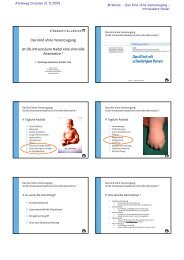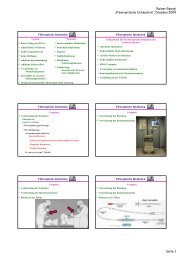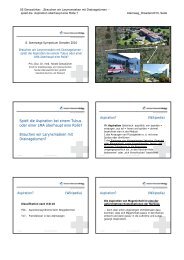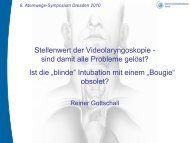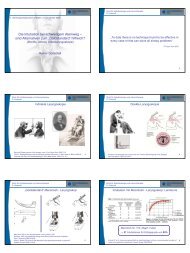R.Gottschall, Beatmung bei FK-Aspiration Seite 1 Atemweg Dresden ...
R.Gottschall, Beatmung bei FK-Aspiration Seite 1 Atemweg Dresden ...
R.Gottschall, Beatmung bei FK-Aspiration Seite 1 Atemweg Dresden ...
You also want an ePaper? Increase the reach of your titles
YUMPU automatically turns print PDFs into web optimized ePapers that Google loves.
<strong>Atemweg</strong> <strong>Dresden</strong> 08.11.2008<br />
R.<strong>Gottschall</strong>, <strong>Beatmung</strong> <strong>bei</strong> <strong>FK</strong>-<strong>Aspiration</strong><br />
<strong>Seite</strong> 1<br />
6. <strong>Atemweg</strong>s-Symposium <strong>Dresden</strong>, 8. November 2008<br />
6. <strong>Atemweg</strong>s-Symposium <strong>Dresden</strong>, 8. November 2008<br />
Vorbemerkungen<br />
Die Fremdkörper - <strong>Aspiration</strong><br />
im Kindesalter<br />
Wann Spontanatmung, wann<br />
kontrollierte <strong>Beatmung</strong> ?<br />
Reiner <strong>Gottschall</strong><br />
Klinik für Anästhesiologie und Intensivtherapie<br />
Universitätsklinikum Jena<br />
■ Keine Leitlinien (außer ERC 2005)<br />
■ Expertenwissen…<br />
■ Vitale Bedrohung<br />
■ <strong>FK</strong> - Extraktion risikobehaftet<br />
■ „Goldstandard“ = Starre Bronchoskopie<br />
6. <strong>Atemweg</strong>s-Symposium <strong>Dresden</strong>, 8. November 2008<br />
Definition<br />
Akzidentelles Eindringen solider Materialien in<br />
(Hypopharynx) Larynx, Trachea oder Bronchien…<br />
→ häufige Ursache akzidenteller Todesfälle <strong>bei</strong> Kindern < 4 J.<br />
■ Akut<br />
■ Subakut / chronisch<br />
≤ 24 h<br />
> 24 h<br />
6. <strong>Atemweg</strong>s-Symposium <strong>Dresden</strong>, 8. November 2008<br />
Epidemiologie<br />
1.< 2. > 3. Lj. ~ 80%<br />
♂ : ♀ 2 : 1<br />
Reilly 1997, Martinot 1997, Dikensoy 2002, Skoulakis 2000, Nicolai 2004, Lea 2005<br />
EU: ~ 5.000 tödliche Erstickungsunfälle <strong>bei</strong> Kindern von 0-14 J. ?<br />
European Survey on Foreign Bodies Injuries (ESFBI, 2004). www.susysafe.org<br />
USA: 2005 > 4.600 Todesfälle durch <strong>FK</strong> - <strong>Aspiration</strong><br />
National Safety Council. Report on injuries in America, 2005. www.nsc.org<br />
Hofmann 1995, Thal 1999, Metrangolo 1999, Marquette 2000, Rummler 2002, Tomaske 2006<br />
6. <strong>Atemweg</strong>s-Symposium <strong>Dresden</strong>, 8. November 2008<br />
Ätiologie<br />
6. <strong>Atemweg</strong>s-Symposium <strong>Dresden</strong>, 8. November 2008<br />
Pathogenese<br />
■ Säugling / Kleinkind<br />
■ Schulkind<br />
~ 80% vegetabile <strong>FK</strong>,<br />
(davon bis > 70% Nüsse…),<br />
Spielzeugteile<br />
Gebrauchsgegenstände,<br />
Spielzeugteile<br />
■ Nahrungsaufnahme<br />
+ körperliche Aktivität / Schreck<br />
■ Spielen / Krabbeln<br />
+ orale „Exploration“<br />
■ Freizeitbeschäftigung / Abgelenktheit / Lachen / Erschrecken, ...<br />
selten:<br />
traumatisch, iatrogen, “endogen”…<br />
Zaytoun 2000, Sersar 2005, Midulla 2005, Tang 2006, Soysal 2006, Brkić 2007<br />
Hofmann 1995, Thal 1999, Marquette 2000, Bloom 2005, Theologos 2007<br />
1
<strong>Atemweg</strong> <strong>Dresden</strong> 08.11.2008<br />
R.<strong>Gottschall</strong>, <strong>Beatmung</strong> <strong>bei</strong> <strong>FK</strong>-<strong>Aspiration</strong><br />
<strong>Seite</strong> 2<br />
6. <strong>Atemweg</strong>s-Symposium <strong>Dresden</strong>, 8. November 2008<br />
6. <strong>Atemweg</strong>s-Symposium <strong>Dresden</strong>, 8. November 2008<br />
■ Anamnese<br />
Diagnostik<br />
odds ratio >7<br />
- plötzliche Hustenattacke<br />
„Penetration“<br />
- Erstickungsanfall<br />
- bronchiale Obstruktion (Giemen)<br />
- „Pfeifen“ / „Keuchen“<br />
Bildgebung<br />
■ Thorax - Röntgen p.a. / seitlich<br />
(+ ggf. in Exspiration)<br />
■ Ggf. Halsweichteile p.a. / seitlich<br />
symptomarmes, -freies Intervall möglich !<br />
■ Untersuchung - unilateral abgeschwächtes AG<br />
- rezidivierender Husten, etc.<br />
- Leukozytose >10.000/µL<br />
■ Bildgebung - direkter Nachweis (
<strong>Atemweg</strong> <strong>Dresden</strong> 08.11.2008<br />
R.<strong>Gottschall</strong>, <strong>Beatmung</strong> <strong>bei</strong> <strong>FK</strong>-<strong>Aspiration</strong><br />
<strong>Seite</strong> 3<br />
6. <strong>Atemweg</strong>s-Symposium <strong>Dresden</strong>, 8. November 2008<br />
Endoskopischer Zugang zum kindlichen <strong>Atemweg</strong><br />
6. <strong>Atemweg</strong>s-Symposium <strong>Dresden</strong>, 8. November 2008<br />
Sichtbarer Fremdkörper im Larynx / Hypopharynx<br />
Magill - Zange<br />
■ Direkte Laryngoskopie<br />
■ Direkt fiberoptisch (ohne Luftbrücke)<br />
■ Gesichtsmaske / Endoskopiemaske<br />
■ Larynxmaske<br />
■ Endotrachealtubus<br />
■ Starres Bronchoskop + Fiberoptik<br />
→ Propofol i.v. vs. Maskeneinleitung<br />
(Sevofluran) ± Succinylcholin<br />
modif. n. Niggemann B et al. Pediatrics International 2004;46:17-21<br />
Rubio Quinones F et al. Pediatr Emerg Care 1995;11:302-3<br />
Mahafza T et al. Int J Pediatr Otolaryngol 2002;64:225-7<br />
Karaman A et al. Int J Pediatr Otolaryngol 2004;68:1189-91<br />
Yalçin S et al. Pediatr Surg Int 2007;23:755-61<br />
6. <strong>Atemweg</strong>s-Symposium <strong>Dresden</strong>, 8. November 2008<br />
Endoskopischer Zugang zum kindlichen <strong>Atemweg</strong><br />
Gesichtsmaske / Mainzer Adapter<br />
Endoskopiemaske n. Frei<br />
Fiberskopie: Larynxmaske + Mainzer Adapter Fiberskopie: Larynxmaske + swivel-Adapter<br />
Yazbeck-Karam VG et al. Paediatr Anaesth 2003;13:691-4<br />
<strong>Gottschall</strong> R AINS 2004;39:497-501<br />
Naguib ML et al. Pediatr Pulmonol 2005;39:56-63<br />
Reyle-Hahn et al. Pediatr Anesth 2000;10:59-63<br />
Niggemann B et al. Pediatr International 2004;46:117-21 Swanson KL Sem Respir Crit Care Med 2004:25.405-11<br />
Trachsel D et al. Eur Respir J 2005;26:773-7<br />
Soysal O et al. Otolaryngol Head Neck Surg 2006:135:232-6<br />
6. <strong>Atemweg</strong>s-Symposium <strong>Dresden</strong>, 8. November 2008<br />
Welche Rolle spielt die flexible Fiberoptik ?<br />
■ Auschlussdiagnostik<br />
Martinot A et al. Indications for flexible versus rigid bronchoscopy in<br />
children with suspekted foreign body aspiration. Am J respir Crit Care Med<br />
1997;155:1676-9<br />
Righini CA et al. What is the diagnostic value of flexible bronchoscopy in<br />
the initial investigation of children with suspected foreign body aspiration?<br />
Int J Pediatr Otorhinolaryngol 2007;71:1383-0<br />
■ Therapie ?<br />
Swanson KL et al. Flexible bronchoscopic management of airway foreign<br />
bodies in children. Chest 2002;121:1695-0<br />
Tang FL et al. Fibrobronchoscopic treatment of foreign body aspiration in<br />
children: an experience of 5 years…Pediatr Surg 2006;41:E1-5<br />
■ Kombination mit starrer Bronchoskopie<br />
Swanson KL. Airway foreign bodies: what‘s new? Sem Respir Crit Care Med<br />
2004:25.405-11<br />
Soysal O et al. Tracheobronchial foreign body aspiration: a continuing<br />
challenge. Otolaryngol Head Neck Surg 2006:135:232-6<br />
6. <strong>Atemweg</strong>s-Symposium <strong>Dresden</strong>, 8. November 2008<br />
Wertigkeit der flexiblen Fiberoptik<br />
6. <strong>Atemweg</strong>s-Symposium <strong>Dresden</strong>, 8. November 2008<br />
Wertigkeit der flexiblen Fiberoptik<br />
Diagnostische Option → unklarer Verdacht ...<br />
Video<br />
Martinot A et al.<br />
Indications for flexible versus rigid bronchoscopy in children with suspected foreign-body<br />
aspiration. Am J Respir Crit Care Med 1997;155:1676-9<br />
Marquette 2000, Dikensoy 2002, Babin 2004, Rouillon 2006, Lea 2005, Karatzanis 2007<br />
Righini CA et al.<br />
What is the diagnostic value of flexible bronchoscopy in the initial investigation of children<br />
with suspected foreign body aspiration?<br />
Int J Pediatr Otorhinolaryngol 2007;71:1383-0<br />
Martinot 1997, Marquette 2000, Dikensoy 2002, Babin 2004, Rouillon 2006, Lea 2005,<br />
Karatzanis 2007<br />
3
<strong>Atemweg</strong> <strong>Dresden</strong> 08.11.2008<br />
R.<strong>Gottschall</strong>, <strong>Beatmung</strong> <strong>bei</strong> <strong>FK</strong>-<strong>Aspiration</strong><br />
<strong>Seite</strong> 4<br />
6. <strong>Atemweg</strong>s-Symposium <strong>Dresden</strong>, 8. November 2008<br />
Differenzialdiagnose: ♂ 3 Jahre, ASA II<br />
(Spontanes Hals- und Mediastinalemphysem, Ausschluss eines<br />
aerodigestiven <strong>FK</strong>)<br />
6. <strong>Atemweg</strong>s-Symposium <strong>Dresden</strong>, 8. November 2008<br />
Differenzialdiagnose: ♂ 3 Jahre, ASA II<br />
(Spontanes Hals- und Mediastinalemphysem, Ausschluss eines<br />
aerodigestiven <strong>FK</strong>)<br />
1. Maskeneinleitung / LA<br />
2. Intubation fiberoptisch<br />
3. Mikrolaryngoskopie<br />
4. Tracheobronchoskopie<br />
5. Ösophagoskopie<br />
6. Intensivtherapie (kurz)<br />
→ Restitutio<br />
Koscielny S, <strong>Gottschall</strong> R HNO 2005;53:645-50<br />
Ötgün I et al. Eur J Pediatr Surg 2008;18:129-0<br />
6. <strong>Atemweg</strong>s-Symposium <strong>Dresden</strong>, 8. November 2008<br />
Welche Rolle spielt die flexible Fiberoptik ?<br />
■ Auschlussdiagnostik<br />
Martinot A et al. Indications for flexible versus rigid bronchoscopy in<br />
children with suspekted foreign body aspiration. Am J respir Crit Care Med<br />
1997;155:1676-9<br />
Righini CA et al. What is the diagnostic value of flexible bronchoscopy in<br />
the initial investigation of children with suspected foreign body aspiration?<br />
Int J Pediatr Otorhinolaryngol 2007;71:1383-0<br />
■ Therapie ?<br />
Swanson KL et al. Flexible bronchoscopic management of airway foreign<br />
bodies in children. Chest 2002;121:1695-0<br />
Tang FL et al. Fibrobronchoscopic treatment of foreign body aspiration in<br />
children: an experience of 5 years…Pediatr Surg 2006;41:E1-5<br />
■ Kombination mit starrer Bronchoskopie<br />
Swanson KL. Airway foreign bodies: what‘s new? Sem Respir Crit Care Med<br />
2004:25.405-11<br />
Soysal O et al. Tracheobronchial foreign body aspiration: a continuing<br />
challenge. Otolaryngol Head Neck Surg 2006:135:232-6<br />
6. <strong>Atemweg</strong>s-Symposium <strong>Dresden</strong>, 8. November 2008<br />
Wertigkeit der flexiblen Fiberoptik<br />
Therapeutische Option:<br />
(= Kontraindikationen für starre Bronchoskopie !)<br />
- Immobile / Instabile HWS*<br />
- Fixierte Kieferklemme<br />
- Traumatisierung Gesichts-, Hirnschädel<br />
♂ 16 J., Mountainbike - Unfall<br />
Borland LM et al.<br />
Frequency of anesthesia-related complications in children with Down syndrome*<br />
under general anesthesia for noncardiac procedures.<br />
Pediatr Anesth 2004;14:733-8<br />
6. <strong>Atemweg</strong>s-Symposium <strong>Dresden</strong>, 8. November 2008<br />
Welche Rolle spielt die flexible Fiberoptik ?<br />
■ Auschlussdiagnostik<br />
Martinot A et al. Indications for flexible versus rigid bronchoscopy in<br />
children with suspekted foreign body aspiration. Am J respir Crit Care Med<br />
1997;155:1676-9<br />
Righini CA et al. What is the diagnostic value of flexible bronchoscopy in<br />
the initial investigation of children with suspected foreign body aspiration?<br />
Int J Pediatr Otorhinolaryngol 2007;71:1383-0<br />
■ Therapie ?<br />
Swanson KL et al. Flexible bronchoscopic management of airway foreign<br />
bodies in children. Chest 2002;121:1695-0<br />
Tang FL et al. Fibrobronchoscopic treatment of foreign body aspiration in<br />
children: an experience of 5 years…Pediatr Surg 2006;41:E1-5<br />
■ Kombination mit starrer Bronchoskopie<br />
Swanson KL. Airway foreign bodies: what‘s new? Sem Respir Crit Care Med<br />
2004:25.405-11<br />
Soysal O et al. Tracheobronchial foreign body aspiration: A continuing<br />
challenge. Otolaryngol Head Neck Surg 2006:135:232-6<br />
Hopkins-Optik<br />
<strong>FK</strong> - Extraktion: starr oder / und flexibel ?<br />
stabiler Ar<strong>bei</strong>ts- und<br />
Ventilationskanal<br />
(= sicherer <strong>Atemweg</strong>)<br />
6. <strong>Atemweg</strong>s-Symposium <strong>Dresden</strong>, 8. November 2008<br />
Gr. 3.7<br />
Saugkatheter Instrumentelle<br />
Vielfalt<br />
„Tasten“, Einhülsen<br />
(Rohrende)<br />
Kombination mit<br />
starrem Rohr<br />
Muntz 2000, Woods 2003, Dix 2003, Nicolai 2004, Niggemann 2004, Soysal 2006, Sersar 2006, Brkić 2007<br />
4
<strong>Atemweg</strong> <strong>Dresden</strong> 08.11.2008<br />
R.<strong>Gottschall</strong>, <strong>Beatmung</strong> <strong>bei</strong> <strong>FK</strong>-<strong>Aspiration</strong><br />
<strong>Seite</strong> 5<br />
6. <strong>Atemweg</strong>s-Symposium <strong>Dresden</strong>, 8. November 2008<br />
Starre Bronchoskopie: Ventilationsprobleme<br />
6. <strong>Atemweg</strong>s-Symposium <strong>Dresden</strong>, 8. November 2008<br />
Nomenklatur: starres Instrumentarium<br />
⋅<br />
Q = ∆ P ⋅ π ⋅ r 4<br />
8 ⋅ η ⋅ L<br />
Masters IB et al.<br />
Airway sizes and proportions in children quantified by<br />
a video-bronchoscopic technique.<br />
BMC Pulmonary Medicine 2006;6:1-8<br />
„Geeignete Referenz für die Proportionen<br />
der zentralen <strong>Atemweg</strong>e <strong>bei</strong> Kindern ist<br />
der Ringknorpel(-Querschnitt),<br />
unabhängig vom Geschlecht, nur indirekt<br />
abhängig von Alter und Körperlänge…“<br />
■ Starre Bronchoskope L (cm) / Gr. ( ) / ID (mm) / OD (mm)<br />
Gr. 3.7 ETT 5.0 Gr. 3.5<br />
Referenz !<br />
Gr. 3.7 ETT 3.5<br />
ID 5.7 5.0 5.0<br />
OD 6.4 6.8 5.7<br />
■ Starre Optiken: 1.9mm / 2.5 - 3.0; 2.8mm / 3.5; 4.0mm / ≥ 4.0<br />
Woods 1987, Marzo 1995, Merkenschlager 1995, Woods 1996, Holinger 1997, Wain 2001<br />
6. <strong>Atemweg</strong>s-Symposium <strong>Dresden</strong>, 8. November 2008<br />
Starre Bronchoskopie: Ventilationsprobleme<br />
6. <strong>Atemweg</strong>s-Symposium <strong>Dresden</strong>, 8. November 2008<br />
Starre Bronchoskopie: Ventilationsprobleme<br />
3) 1)<br />
4)<br />
2)<br />
■ Leckage↓ [Krikoid] 1)<br />
■ Instrumentierung 2)<br />
■ Rohrposition [bronchial] 3)<br />
■ <strong>FK</strong> - Position [bronchial] 4)<br />
Woods AM, Gal TJ. Decreasing airflow resistance during infant and pediatric bronchoscopy.<br />
Anesth Analg 1987;66:457-9<br />
Marzo SJ, Hotaling AJ. Trade-off between airway resistance and optical resolution in pediatric<br />
rigid bronchoscopy. Ann Otol Rhinol Laryngol 1995;104:282-7<br />
Spontan: C L ↓;Atemar<strong>bei</strong>t↑; Hypoventilation; FRC↓<br />
Kontrolliert: pulmonale Überblähung; Barotrauma; HZV↓; CO 2 ↑<br />
Lockhart 1984, Koloske 1991, Wood 1996, Biro 2001, Dix 2003, Farrell 2004<br />
6. <strong>Atemweg</strong>s-Symposium <strong>Dresden</strong>, 8. November 2008<br />
Starre Bronchoskopie: (ass.) Spontanatmung /<br />
Überdruckbeatmung<br />
6. <strong>Atemweg</strong>s-Symposium <strong>Dresden</strong>, 8. November 2008<br />
Starre Bronchoskopie: Jet - Ventilation<br />
1) <strong>Beatmung</strong>sanschluss<br />
2) Verschluss JV - Port<br />
3) Verschluss prox. Rohrende<br />
→ Wechselschieber<br />
4) Kaltlichtanschluss<br />
4)<br />
1)<br />
2)<br />
3)<br />
Video<br />
Biro/<strong>Gottschall</strong>/Klein/Wiedemann:<br />
Jet-Ventilation, Lehrvideo 2001<br />
offen<br />
offen<br />
Kanüle f. JV<br />
Litman 2000, Dix 2003, Soodan 2004, Babin 2004, Farrell 2004, Buu 2005, Divisi 2006, Tomaske 2006,<br />
Mauser 2007, Yadav 2007, Brkić 2007, Pinzoni 2007<br />
Pro:<br />
Versichelen 1985, Baraka 1996, Biro 2001, Zaytoun 2000, Karakoç 2002, Dikensoy 2002, <strong>Gottschall</strong> 2004<br />
Con:<br />
Dix 2003, Farrell 2004, Babin 2004<br />
5
<strong>Atemweg</strong> <strong>Dresden</strong> 08.11.2008<br />
R.<strong>Gottschall</strong>, <strong>Beatmung</strong> <strong>bei</strong> <strong>FK</strong>-<strong>Aspiration</strong><br />
<strong>Seite</strong> 6<br />
6. <strong>Atemweg</strong>s-Symposium <strong>Dresden</strong>, 8. November 2008<br />
Der akute <strong>Atemweg</strong>s - <strong>FK</strong><br />
♂ 2 3 / 12<br />
Jahre, Erdnuss - Stücke re. Bronchialsystem<br />
6. <strong>Atemweg</strong>s-Symposium <strong>Dresden</strong>, 8. November 2008<br />
Der chronische <strong>Atemweg</strong>s - <strong>FK</strong><br />
♂ 1 6 / 12 Jahre, bekanntes Kleinkind-Asthma…<br />
→ Beobachtetes <strong>Aspiration</strong>sereignis (2 Wochen zuvor !)<br />
→ Bildgebung + klinischer Befund suspekt !<br />
→ Antiobstruktive Therapie (4 Tage stationär UKJ…!)<br />
→ <strong>FK</strong> - Verdacht, Extraktion Erdnuss - Stück (starr + flexibel)<br />
→ Postinterventionell ausgeprägte Obstruktion…<br />
Video<br />
Video<br />
6. <strong>Atemweg</strong>s-Symposium <strong>Dresden</strong>, 8. November 2008<br />
Starre Bronchoskopie: (ass.) Spontanatmung /<br />
Überdruckbeatmung<br />
6. <strong>Atemweg</strong>s-Symposium <strong>Dresden</strong>, 8. November 2008<br />
Argumente Pro Spontanatmung<br />
■ (Ass.) Spontanatmung<br />
- inhalativ + LA<br />
(Brkić & Umihanić J Pediatr Otorhinolaryngol 2007;71:909-15)<br />
- TIVA + LA<br />
(Buu & Ansermino Pediatr Anesth 2005;15:533)<br />
■ IPPV manuell / PCV maschinell<br />
- inhalativ ± LA<br />
(Aydoğan LF et al J Pediatr Otorhinolaryngol 2006;70:823-8)<br />
-TIVA ± LA<br />
(Tomaske M et al. Pediatr Anesth 2006;16:123-9)<br />
■ Vermeiden beatmungsbedingter <strong>FK</strong> - Dislokation ?<br />
■ Vermeiden poststenotischer Überblähung („ball-valve“) ?<br />
■ Vermeiden kompletter <strong>Atemweg</strong>sobstruktion ?<br />
■ Kontinuierliche Ventilation ?<br />
■ Vermeiden einer Barotrauma - Eskalation<br />
■ Vermeiden eines Muskelrelaxanz(- Überhangs)<br />
Litman 2000, Dix 2003, Farrell 2004, Buu 2005, Brkić 2007, Pinzoni 2007<br />
6. <strong>Atemweg</strong>s-Symposium <strong>Dresden</strong>, 8. November 2008<br />
Argumente Pro kontrollierte <strong>Beatmung</strong><br />
6. <strong>Atemweg</strong>s-Symposium <strong>Dresden</strong>, 8. November 2008<br />
Ventilationsvergleich <strong>bei</strong> starrer Bronchoskopie<br />
■ Optimierter Gaswechsel (IPPV manuell; Jet - Ventilation)<br />
■ Kompensation erhöhter Resistance (<strong>Atemweg</strong>, Instrumente)<br />
■ Immobilisierung (Hustenreflex; Bewegungen)<br />
■ Optimierte Endoskopiebedingungen (Apnoe optional)<br />
■ Kürzere Untersuchungsdauer<br />
■ Vermeiden von Atelektasen<br />
■ Optimierte Anpassung der Narkosetiefe (↓Morbidität)<br />
Litman 2000, Soodan 2004, Babin 2004, Farrell 2004, Divisi 2006, Tomaske 2006, Mauser 2007, Yadav 2007<br />
6
<strong>Atemweg</strong> <strong>Dresden</strong> 08.11.2008<br />
R.<strong>Gottschall</strong>, <strong>Beatmung</strong> <strong>bei</strong> <strong>FK</strong>-<strong>Aspiration</strong><br />
<strong>Seite</strong> 7<br />
6. <strong>Atemweg</strong>s-Symposium <strong>Dresden</strong>, 8. November 2008<br />
Ventilationsvergleich <strong>bei</strong> starrer Bronchoskopie<br />
6. <strong>Atemweg</strong>s-Symposium <strong>Dresden</strong>, 8. November 2008<br />
Ventilationsvergleich <strong>bei</strong> starrer Bronchoskopie<br />
n = 36<br />
Atropin i.v.<br />
Halothan od. Thiopental + Lidocain (Larynx)<br />
Gruppe I<br />
⇨ kontrolliert (IPPV manuell), Halothan + Succinylcholin<br />
Gruppe II<br />
⇨ spontan, Halothan<br />
i.v. Lidocain (1.5 mg/kg) vor Ausleitung<br />
Soodan A et al. Pediatr Anesth 2004;14:947-52<br />
Soodan A et al. Pediatr Anesth 2004;14:947-52<br />
6. <strong>Atemweg</strong>s-Symposium <strong>Dresden</strong>, 8. November 2008<br />
6. <strong>Atemweg</strong>s-Symposium <strong>Dresden</strong>, 8. November 2008<br />
Ventilationsvergleich <strong>bei</strong> starrer Bronchoskopie Anästhesiemodus: Gas oder TIVA ?<br />
■ Inadäquate Narkosetiefe (Leckage) Gruppe II<br />
■ Inadäquate Schleimhautanästhesie<br />
Soodan A et al. Pediatr Anesth 2004;14:947-52<br />
Cunnington / De Beer Pediatr Anesth 2005;15:534-5<br />
■ Studienpopulation zu gering<br />
■ Maskeninduktion + TIVA möglich (spontan)<br />
Buu / Ansermino Pediatr Anesth 2005;15:533<br />
■ Lachgas ist kontraindiziert<br />
■ Volatila sind möglich (Sevofluran empfohlen)<br />
<strong>bei</strong> starrer Bronchoskopie werden die<br />
zulässigen MAK - Werte überschritten !<br />
Westphal K u. Mitarb. Ar<strong>bei</strong>tsplatzbelastung durch Sevofluran.<br />
Konzentrationsmessungen während Bronchoskopien <strong>bei</strong> Kindern.<br />
Anaesthesist 1997;46:677-82<br />
Gentili A et al. Exposure of personnel to sevoflurane during paediatric<br />
anaesthesia… Eur J Anaesthesiol 2004;21:638-45<br />
■ Überwiegend chronische <strong>FK</strong> (≥ 24 Std)…<br />
■ Nach Induktion (Maske vs. i.v.) TIVA sinnvoll…<br />
6. <strong>Atemweg</strong>s-Symposium <strong>Dresden</strong>, 8. November 2008<br />
Fazit: Wann (ass.) Spontanatmung ?<br />
6. <strong>Atemweg</strong>s-Symposium <strong>Dresden</strong>, 8. November 2008<br />
Fazit: Wann kontrollierte <strong>Beatmung</strong> ?<br />
■ Respiratorische Stabilität<br />
■ Endoskopische Ausschlussdiagnostik<br />
■ Hinweise für Barotrauma<br />
■ Mutmaßliche <strong>FK</strong> - Position laryngeal / tracheal<br />
■ Respiratorische Insuffizienz<br />
■ V.a. subakuten / chronischen <strong>FK</strong><br />
■ Mutmaßliche <strong>FK</strong> - Position bronchial<br />
■ Explorativbronchoskopie (starr)<br />
■ Klinikeigene Präferenzen<br />
■ Klinikeigene Präferenzen<br />
7
<strong>Atemweg</strong> <strong>Dresden</strong> 08.11.2008<br />
R.<strong>Gottschall</strong>, <strong>Beatmung</strong> <strong>bei</strong> <strong>FK</strong>-<strong>Aspiration</strong><br />
<strong>Seite</strong> 8<br />
6. <strong>Atemweg</strong>s-Symposium <strong>Dresden</strong>, 8. November 2008<br />
Weshalb bleibt die Datenlage unübersichtlich ?<br />
6. <strong>Atemweg</strong>s-Symposium <strong>Dresden</strong>, 8. November 2008<br />
Von außerordentlicher Bedeutung sind ferner:<br />
Für die kindliche <strong>FK</strong> - Extraktion ist die Gewinnung<br />
plausibler Vergleichsdaten zum Ventilationsund<br />
/ oder Anästhesiemodus problematisch !<br />
■ Individualisierte Vorgehensweise<br />
■ Teamexpertise und Teamar<strong>bei</strong>t<br />
■ Geeignetes Instrumentarium<br />
■ Örtliche Logistik<br />
■ Geringe Morbidität / Mortalität<br />
■ Kurze Hospitalisierung<br />
Uniklinikum Jena, HNO - Klinik<br />
Danke für Ihr Interesse !<br />
Uniklinikum Jena - Lobeda<br />
8





